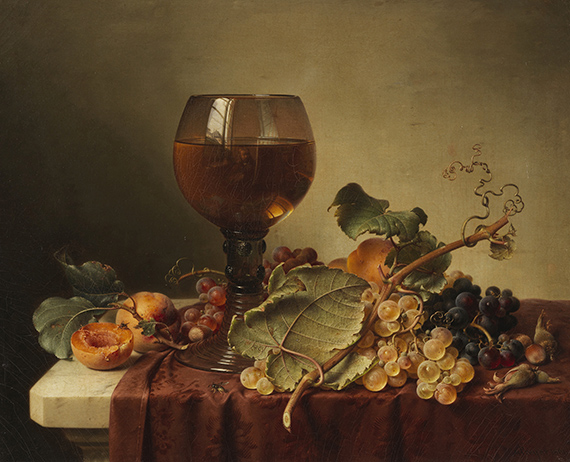631
Johann Wilhelm Preyer
Stillleben mit Selbstportrait im Weinglas und Früchten, 1861.
Oil on canvas
Estimation:
€ 50,000 / $ 58,000 Résultat:
€ 111,125 / $ 128,904 ( frais d'adjudication compris)
Stillleben mit Selbstportrait im Weinglas und Früchten. 1861.
Oil on canvas.
Lower right signed and dated. 42 x 51.5 cm (16.5 x 20.2 in).
• Preyer is considered the most important still life painter of the Düsseldorf School.
• Masterful recourse and reinterpretation of the iconic works of Dutch Baroque.
• Special composition with a hidden self-portrait.
• Other still lifes are in the Alte Nationalgalerie, Berlin, the Museum Kunstpalast, Düsseldorf, while most are privately-owned.
PROVENANCE: Private collection USA.
Oil on canvas.
Lower right signed and dated. 42 x 51.5 cm (16.5 x 20.2 in).
• Preyer is considered the most important still life painter of the Düsseldorf School.
• Masterful recourse and reinterpretation of the iconic works of Dutch Baroque.
• Special composition with a hidden self-portrait.
• Other still lifes are in the Alte Nationalgalerie, Berlin, the Museum Kunstpalast, Düsseldorf, while most are privately-owned.
PROVENANCE: Private collection USA.
Johann Wilhelm Preyer is considered the most important still life painter of the Düsseldorf School, where he helped the genre, which had received little attention for a long time, to flourish again. Coming from a family of artists, Preyer already specialized in this genre while he was studying at the Düsseldorf Academy from 1822, despite the influence of his teachers Peter von Cornelius and Wilhelm Schadow, who excelled in history and figure painting. This is all the more astonishing given that when the Academy was re-established in 1819, there were initially no specialists in this field, and the still life as a genre occupied a subordinate position behind history paintings, portraits and landscapes. Extensive study trips then led Preyer to Holland in 1835, where he trained his eye on the Old Masters of Dutch Baroque in the variety of compositions and their outstanding technical ability. After stays in Munich, Venice, northern Italy and Switzerland, he returned to Düsseldorf in 1844. His works quickly aroused the interest of important collectors of the time, such as Joachim Heinrich Wilhelm Wagener, whose collection laid the foundation for the Alte Nationalgalrie and through which some of Preyer's paintings found their way there. Preyer's still lifes follow the meticulous richness of detail and the precise description of the materiality of Dutch models, but without adopting their depiction. What is dominant in his work is a restrained elegance and harmony in composition and coloring, as well as in the selection of objects. As a balanced triangle in the present work, he groups a few hazelnuts, peaches, white and red grapes around the rummer filled with white wine. The ornamental tendrils and leaves of the vine meander through the round fruits. A drop of sweet juice runs down the sliced peach, a fly and a wasp, described in great detail, populate the picture. The different textures and transparencies, as well as materials such as the smooth marble and the soft red cloth, prompt intensive close-up study for an attentive and searching gaze, which is ultimately rewarded with the self-portrait reflected in the glass and the view from the studio window . During his lifetime, Preyer celebrated great successes, most of his works went into private ownership right from the studio, often into the hands of private American collections. [KT]
631
Johann Wilhelm Preyer
Stillleben mit Selbstportrait im Weinglas und Früchten, 1861.
Oil on canvas
Estimation:
€ 50,000 / $ 58,000 Résultat:
€ 111,125 / $ 128,904 ( frais d'adjudication compris)




 Lot 631
Lot 631 